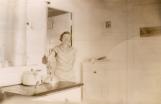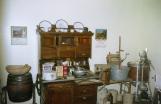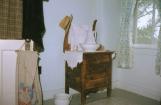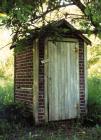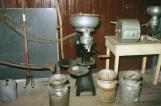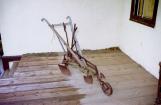2
Typical Week For WivesWinter melt snow or ice for washing on Monday. Hang everything on line - wring by hand or wringer. Rub clothes of course on ribbed glass wash board until clean.
Boil towels and tea towels and dirty clothes on stove in boiler until clean. Use a piece of home made lye soap or also lye for boiling - rinse with clean water and a little bit of bluing dissolved in water to take greyness away.
Starch fancy clothes and crochet work, shirts, pillow cases aprons etc, roll up individually and dampen all before ironing.
Wednesday was bread baking day and mending.
Thursday and Friday was house cleaning.
Saturday - pie baking etc, bread and rolls etc.
My history was two big batches of bread twice week, setting yeast and water and soft dough night before, keeping warm and next morning when risen add to the batch of four you would use.
Heat cook stove to 325 - 350 with wood, coal or cow chips and bake loaves in oven for 1 hour.
After enough cream has been separated - turn into butter churn or use quart sealer and shake until butter forms. Drain off butter milk and wash several times in cold water. Add salt and form into pounds with butter mold - keep cold.
All spices were used by baking and pickling. Sad irons were heated on stove for ironing clothes. Reservoir on stove holds water warm for dishes etc. Crocks were used for sour kraut made from heads of cabbage and cured by methods.
Meat grinder on cupboard was used for grinding pork for sausage or hamburger meat. Also grinding onions or vegetables. Flour sifter was used for sifting flour for baking bread etc.
Strainers for straining foods cooked in water - macaroni or vegetables or ?
4
Washing ClothesEvery family had a big iron kettle. It sat on bricks on rocks. Wood was placed around it and a fire started. The water boiled. You then cut off shaving from a bar of homemade soap and dropped them in the boiling water, then in went the clothes. They were stirred and stirred with a long paddle. After about an hour or so of time, a garment would be lifted out by the paddle and layed on the scrub board to be scrubbed. After a good rub a dub dub on the old scrub board, the garment was rinsed in fresh water and hung up to dry. At the end of the day there were a few blisters on the hands. It was a whole days work, almost always done on Monday, and always a pot of beans was our dinner, no time to cook anything else.
Making Soap
Everyone made his own soap. It was made once a year. In the late fall at butchering time because the fat parts of the pig were boiled and stirred in the same big black kettle that clothes were boiled in. The grease was necessary to make soap. Another ingredient was lye. I don't know what else they used. But after it was mixed and cooked, it was poured out to dry and then cut up in cakes. Supposedly, the whiter the soap, the better it was but I remember very little white soap. It generally had a muddy water color to it.
6
The WashstandThe washstand was an essential piece of furniture in a pioneer's home. The basin and pitcher (ewer) filled with hauled water (no running water in those days) heated in the stove's reservoir or on top in a pot to be poured into the basin and with a piece of home made hand soap, one could wash hands and face and sometimes the whole body if quick. Some water was saved to shave. Of course, these sets contained the all essential chamber pot cleaned and stored by day in the washstand cupboard, then placed under the bed for convenience in case of necessity.
8
The OuthouseAs the homesteaders came to settle, three buildings broke the monotony of the prairie, a house, a barn and an outhouse. It's not certain which one held top priority. The position of the outhouse in relation to other farm necessities was absolutely essential. The pathway between it and the house should go by the garden, the woodpile and the well, in a properly planned farmyard. That way you could bring vegetables from the garden, wood for the wood box and a pail of water for the kitchen on your return journey.
Various styles of architecture could be seen in the roof construction. Most had a half moon for light and air conditioning. There was no sex discrimination. It was used by both setters and pointers. Privacy was afforded by a wire hook and nail, usually the wire was from the handle of a lard pail. Before the modern use of toilet paper, the newspaper, Eaton's catalogue and in the fall fruit wrappers were most acceptable.
The new rich and pretentious even went to the blatant display of new found wealth and shingled and painted it. Some of the idle rich even added a third hole for small folk. Many a small child sat on a large hole with great doubts and justifiable fears of falling through and down to a grizzly end, before Mum or Dad could rescue them. They even put up a roll of toilet paper on a sawed-off broom handle. The toilet paper was usually taken down after company left.
It was the one place a person could go to meditate and even Mum and Dad didn't bother you about dawdling. If you craved company, sisters could get together, ponder the occurrences of the day, the latest couples at school, and gossip. Boys could discuss baseball, the new girl in school or affairs of state. Mother could get away from household chores, worries of cutworm and grasshoppers in the garden and the children's constant requests of her time. Federally the nation's major decisions were made in the Upper or Lower House; locally the Backhouse.
Seasons changed but the old two-holer served the family through rain, cold, storm and heat. When winter set in there was no such thing as a frivolous visit. Courage, hardiness and real necessity were the only reasons to trudge through the snow to the outhouse. Chilblains on your bottom were the result of an icy sit, followed by a hasty return to the kitchen where a long sit on the oven door brought circulation back to normal.
Hallowe'en pranksters would upset it, then it became most urgent to right it immediately to answer the next urgent call.
There it stands, neglected, forlorn, door hanging on one hinge, an essential part of our past life. Perhaps some of these committees bent on preserving buildings of the past could declare one a Heritage Building and it could go down in its rightful place in history.
10
A Cream SeparatorCows were usually milked twice a day - morning and evening. The fresh milk was poured into the top of the separator. The crank was turned at just the right speed so that the centrifugal force separated the cream from the milk. The cream came out one spout and was collected in a cream can to be shipped and sold to the dairy. Skim milk from the other spout, was collected and served to the family, or fed to the calf. Cleaning the separator after each use was a dreaded, hour-long chore.
12
A Potato PlanterPotatoes were a staple food for homesteaders. This implement, similar to a plow, would leave a trench in which potatoes could be planted.
14
Pioneer WomenOur pioneer women stood shoulder to shoulder with the men as they broke the land and established the communities we enjoy to-day. They raised their families and kept the home fires burning. They cooked on wood burning stoves on which they also heated water in the old copper boiler for wash-days and baths. The water was hauled in to cisterns or gathered in rain barrels and snow was melted in winter--it took a lot of snow for little water. The women made their own lye soap for washing clothes and cranked the wringer by hand after scrubbing the clothes on a scrub board. Clothes were placed on a clothes horse to dry--especially after freezing solid on the line outside to give them that ‘oh so fresh' smell. The sad irons, heated on the stove, pressed the clothes smooth and helped develop strong arm muscles just from their weight.
She milked the cows, separated the milk and churned the cream into butter. If there was more than the family could consume, she often traded fresh butter, along with eggs from the chickens she raised, for groceries when money was short. Many a hen was confused and wondered why her brood took to the water sometimes, not knowing their nests had been set with duck or goose eggs to be hatched. In the meantime, the housewife planted and cared for the garden, growing vegetables to store and preserve along with the fruit and meat that she canned. No refrigeration then. She cooked for harvest crews serving lunches and hot meals, baking cans full of cookies and scores of pies. She was probably the last one to bed by the evening lamplight and was up early with the morning sunrise.
She found time to socialize at local picnics, dances and concerts in the country school house. Visits to neighbouring homes to play cards or games or just a friendly visit helped to take away the loneliness on the open prairie.
